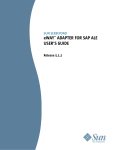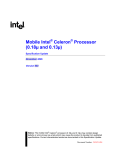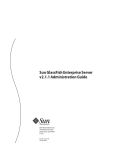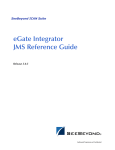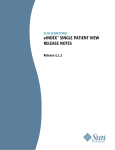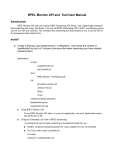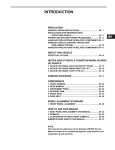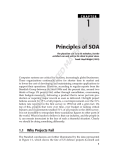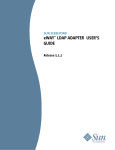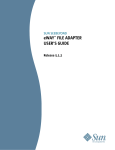Download Planning for Java CAPS Installation
Transcript
Planning for Java CAPS Installation Sun Microsystems, Inc. 4150 Network Circle Santa Clara, CA 95054 U.S.A. Part No: 820–3741–12 March 2009 Copyright 2008 Sun Microsystems, Inc. 4150 Network Circle, Santa Clara, CA 95054 U.S.A. All rights reserved. Sun Microsystems, Inc. has intellectual property rights relating to technology embodied in the product that is described in this document. In particular, and without limitation, these intellectual property rights may include one or more U.S. patents or pending patent applications in the U.S. and in other countries. U.S. Government Rights – Commercial software. Government users are subject to the Sun Microsystems, Inc. standard license agreement and applicable provisions of the FAR and its supplements. This distribution may include materials developed by third parties. Parts of the product may be derived from Berkeley BSD systems, licensed from the University of California. UNIX is a registered trademark in the U.S. and other countries, exclusively licensed through X/Open Company, Ltd. Sun, Sun Microsystems, the Sun logo, the Solaris logo, the Java Coffee Cup logo, docs.sun.com, Java, and Solaris are trademarks or registered trademarks of Sun Microsystems, Inc. or its subsidiaries in the U.S. and other countries. All SPARC trademarks are used under license and are trademarks or registered trademarks of SPARC International, Inc. in the U.S. and other countries. Products bearing SPARC trademarks are based upon an architecture developed by Sun Microsystems, Inc. The OPEN LOOK and SunTM Graphical User Interface was developed by Sun Microsystems, Inc. for its users and licensees. Sun acknowledges the pioneering efforts of Xerox in researching and developing the concept of visual or graphical user interfaces for the computer industry. Sun holds a non-exclusive license from Xerox to the Xerox Graphical User Interface, which license also covers Sun's licensees who implement OPEN LOOK GUIs and otherwise comply with Sun's written license agreements. Products covered by and information contained in this publication are controlled by U.S. Export Control laws and may be subject to the export or import laws in other countries. Nuclear, missile, chemical or biological weapons or nuclear maritime end uses or end users, whether direct or indirect, are strictly prohibited. Export or reexport to countries subject to U.S. embargo or to entities identified on U.S. export exclusion lists, including, but not limited to, the denied persons and specially designated nationals lists is strictly prohibited. DOCUMENTATION IS PROVIDED “AS IS” AND ALL EXPRESS OR IMPLIED CONDITIONS, REPRESENTATIONS AND WARRANTIES, INCLUDING ANY IMPLIED WARRANTY OF MERCHANTABILITY, FITNESS FOR A PARTICULAR PURPOSE OR NON-INFRINGEMENT, ARE DISCLAIMED, EXCEPT TO THE EXTENT THAT SUCH DISCLAIMERS ARE HELD TO BE LEGALLY INVALID. 090519@22510 Contents Planning for Java CAPS Installation ................................................................................................... 5 Java CAPS Supported Operating Systems ...........................................................................................7 Java CAPS Components and Supported External Systems ...............................................................9 System Requirements .......................................................................................................................... 14 Before You Install ................................................................................................................................ 18 About the Installation ......................................................................................................................... 18 Overview of the Graphical User Interface Installation Process .............................................. 19 Overview of the Command-line Interface Installation Process ............................................. 21 Java CAPS Component Names .................................................................................................. 22 Repository Names and User Names .......................................................................................... 24 Environment Names .................................................................................................................... 24 Installation Media ................................................................................................................................ 25 Contents of the Java CAPS “installer” and “components” Download Files .......................... 25 Contents of the Installation DVDs ............................................................................................. 29 Preparing for Installation ................................................................................................................... 30 JDK and JAVA_HOME ............................................................................................................... 30 Upgrading to 6 .............................................................................................................................. 31 Java CAPS Installer Caveats ............................................................................................................... 31 Creating a Windows Service for Sun Java System Application Server .......................................... 35 Increasing the NetBeans IDE Heap Size ........................................................................................... 36 ▼ To Increase the Heap Size in NetBeans IDE ............................................................................. 36 UNIX and Linux Patches .................................................................................................................... 37 Checking Patch Levels ................................................................................................................. 37 Certified Sun Solaris 9 and 10 Patches ....................................................................................... 37 IBM AIX 5L 5.2 and 5.3 Patches ........................................................................................................ 38 Certified IBM AIX 5L Version 5.2 Patches ............................................................................... 38 Certified IBM AIX 5L Version 5.3 Patches ............................................................................... 38 Linux Patches ....................................................................................................................................... 39 3 Contents Certified SUSE Linux Enterprise Server 10 Daylight Savings Time Patch ............................ 39 4 Planning for Java CAPS Installation • March 2009 Planning for Java CAPS Installation The topics listed here provide pertinent information that you should be aware of prior to attempting to install the JavaTM Composite Application Platform Suite (Java CAPS). If you have any questions or problems, see the Java CAPS Support web site at http://goldstar.stc.com/ support. Tip – To access all the Java CAPS documentation in HTML format on the Sun Developer Network (SDN) web site, go to http://developers.sun.com/docs/javacaps/. You can also access the Java CAPS documentation on the SDN web site by clicking the HELP tab in Enterprise Manager. The HELP tab in the Java CAPS Uploader opens the “Installing Java CAPS Components Using the Java CAPS Uploader” topic. What You Need to Know Before Installing ■ ■ ■ ■ ■ ■ ■ ■ ■ ■ “Java CAPS Supported Operating Systems” on page 7 “Java CAPS Components and Supported External Systems” on page 9 “System Requirements” on page 14 “Before You Install” on page 18 “About the Installation” on page 18 “Installation Media” on page 25 “Preparing for Installation” on page 30 “Java CAPS Installer Caveats” on page 31 “Increasing the NetBeans IDE Heap Size” on page 36 “UNIX and Linux Patches” on page 37 Beginning with Java CAPS 6, GUI and command-line installations are available for all supported operating systems. The GUI installation enables you choose a complete or a custom 5 Planning for Java CAPS Installation installation and the command-line installation enables you to either set what you want to install in a properties file that is invoked via a script or to run an interactive installation wherein you answer system installation questions. A complete installation includes the following components: ■ Sun Java System Application Server (SJSAS) 9.1 UR2 A Java Enterprise Edition (Java EE) 5 compatible platform for developing and delivering server side Java applications and web services. It enables you to deploy and monitor Java Business Integration (JBI) based Projects. ■ NetBeans IDE 6.1 ML An integrated development environment (IDE) for writing, testing, and debugging secure service-oriented architecture (SOA) applications using XML, BPEL, and Java web services. You use the NetBeans IDE to develop and configure a Java CAPS system. ■ Java CAPS Repository v. 6 A NetBeans IDE Update Center host and a distributed version control system for non-JBI based Java CAPS Projects and objects. ■ Enterprise Service Bus API Kit, which includes ■ ■ ■ Java CAPS Management API STCMS API Sun JMS IQ Manager v. 6 A Sun JMS IQ Manager that is required to run Non-JBI based Projects. ■ UDDI Server An XML-based registry which enables e-commerce on the web. ■ Enterprise Manager v. 6 A web-based application that is used to deploy and monitor Java CAPS runtime components. 6 ■ Java CAPS Installer ■ Java CAPS Uploader ■ Domain ■ Core components, such as the Enterprise Service Bus (formerly eGate Integrator) ■ Add-on components, such as Sun Adapters (formerly eWays) ■ JBI components Planning for Java CAPS Installation • March 2009 Java CAPS Supported Operating Systems Java CAPS Supported Operating Systems This topic lists the supported operating system requirements for each platform. The requirements listed in this topic are in addition to the supported system requirements. In previous releases of Java CAPS the operating systems supported runtime while only Windows systems supported design-time. With this release, we have separated the supported operating systems into two categories: Design-time (NetBeans IDE) and Runtime (Sun Java System Application Server). Supported Design-time Platforms NetBeans IDE is available on these operating systems: ■ Sun Solaris 10 SPARC ■ Sun Solaris 10 x86 (64 bit) ■ Sun Solaris 10 x86 (32 bit) ■ Apple Mac OS Tiger 10.4 (32 bit) ■ Microsoft Windows Vista (32 bit) ■ Microsoft Windows XP SP2 (32 bit) ■ Microsoft Windows XP SP3 (32 bit) (new in Java CAPS Release 6 Update 1) ■ Microsoft Windows Server 2003 R2 SP2 (32 bit) ■ Microsoft Windows 2000 SP4 (32 bit) ■ Red Hat Enterprise Linux AS 4 (64 bit) ■ Red Hat Enterprise Linux AS 4 (32 bit) ■ Chinese (Simplified and Traditional) Sun Solaris 10 SPARC with required patches (JVM: 32 and 64 bit) ■ Chinese (Simplified and Traditional) Microsoft Windows 2000 SP4, Windows XP SP2, Windows Server 2003 SP2 and R2, and Windows Vista (32 bit) ■ Japanese Sun Solaris 10 SPARC with required patches (JVM: 32 and 64 bit) ■ Japanese Microsoft Windows 2000 SP4, Windows XP SP2, Windows Server 2003 SP2 and R2, and Windows Vista (32 bit) ■ Korean Sun Solaris 10 SPARC with required patches (JVM: 32 and 64 bit) ■ Korean Microsoft Windows 2000 SP4, Windows XP SP2, Windows Server 2003 SP2 and R2, and Windows Vista (32 bit) Supported Runtime Platforms Sun Java System Application Server 9.1 UR2 is available on these operating systems: ■ Sun Solaris 10 SPARC (JVM: 32 and 64 bit) Planning for Java CAPS Installation 7 Java CAPS Supported Operating Systems 8 ■ Sun Solaris 10 x86 (OS: 64 bit; JVM: 32 bit) ■ Sun Solaris 10 x86 (OS: 32 bit; JVM: 32 bit) ■ Sun Solaris 9 SPARC (JVM: 32 bit) ■ Open Solaris 2008.05 (new in Java CAPS Release 6 Update 1; evaluation support only) ■ Apple Mac OS Tiger 10.4 (OS: 32 bit; JVM: 32 bit) ■ IBM AIX 5L 5.3 (OS: 64 bit; JVM: 32 bit) ■ IBM AIX 5L 5.2 (OS: 32 bit; JVM: 32 bit) ■ Microsoft Windows Vista Business (OS: 32 bit; JVM: 32 bit) ■ Microsoft Windows XP SP2 (OS: 32 bit; JVM: 32 bit) ■ Microsoft Windows XP SP3 (OS: 32 bit; JVM: 32 bit) (new in Java CAPS Release 6 Update 1) ■ Microsoft Windows Server 2003 EE R2 SP2 (OS: 64 bit; JVM: 32 bit) ■ Microsoft Windows Server 2003 R2 SP2 (OS: 32 bit; JVM: 32 bit) ■ Microsoft Windows 2000 SP4 (OS: 32 bit; JVM: 32 bit) ■ Red Hat Enterprise Linux AS 5 (OS: 64 bit; JVM: 32 bit) ■ Red Hat Enterprise Linux AS 5 (OS: 32 bit; JVM: 32 bit) ■ Red Hat Enterprise Linux AS 4 (OS: 64 bit; JVM: 32 bit) ■ Red Hat Enterprise Linux AS 4 (OS: 32 bit; JVM: 32 bit) ■ Red Hat Enterprise Linux AS 3 (OS: 64 bit; JVM: 32 bit) ■ Red Hat Enterprise Linux AS 3 (OS: 32 bit; JVM: 32 bit) ■ SUSE Linux Enterprise Server 10 (OS: 64 bit; JVM: 32 bit) ■ SUSE Linux Enterprise Server 9 (OS: 32 bit; JVM: 32 bit) ■ Chinese (Simplified and Traditional) Sun Solaris 10 SPARC with required patches (JVM: 32 bit and 64 bit) ■ Chinese (Simplified and Traditional) Sun Solaris 10 x86 (JVM: 32 bit and 64 bit) ■ Chinese (Simplified) Sun Solaris 9 SPARC with required patches ■ Chinese (Simplified) Sun Solaris 9 x86 ■ Chinese (Simplified and Traditional) Microsoft Windows 2000 SP4, Windows XP SP2, Windows Server 2003 SP2 and R2, and Windows Vista (32 bit) ■ Chinese (Simplified and Traditional) Red Hat Enterprise Linux AS 4 (OS: 32 bit; JVM: 64 bit) ■ Chinese (Simplified and Traditional) Red Hat Enterprise Linux AS 3 (OS: 32 bit; JVM: 64 bit) ■ Japanese Sun Solaris 10 SPARC with required patches (JVM: 32 bit and 64 bit) ■ Japanese Sun Solaris 9 SPARC with required patches Planning for Java CAPS Installation • March 2009 Java CAPS Components and Supported External Systems ■ Japanese Sun Solaris 10 x86 (JVM: 32 bit and 64 bit) ■ Japanese Sun Solaris 9 x86 ■ Japanese IBM AIX 5L, version 5.2 (32 bit) with required maintenance level patches ■ Japanese Microsoft Windows 2000 SP4, Windows XP SP2, Windows Server 2003 SP2 and R2, and Windows Vista (32 bit) ■ Japanese Red Hat Enterprise Linux AS 4 (OS: 32 bit; JVM: 64 bit) ■ Japanese Red Hat Enterprise Linux AS 3 (OS: 32 bit; JVM: 64 bit) ■ Korean Sun Solaris 10 SPARC with required patches (JVM: 32 bit and 64 bit) ■ Korean Sun Solaris 9 SPARC with required patches ■ Korean Sun Solaris 10 x86 (JVM: 32 bit and 64 bit) ■ Korean Sun Solaris 9 x86 ■ Korean IBM AIX 5L, version 5.2 (32 bit) with required maintenance level patches ■ Korean Microsoft Windows 2000 SP4, Windows XP SP2, Windows Server 2003 SP2 and R2, and Windows Vista (32 bit) ■ Korean Red Hat Enterprise Linux AS 4 (OS: 32 bit; JVM: 64 bit) ■ Korean Red Hat Enterprise Linux AS 3 (OS: 32 bit; JVM: 64 bit) Note – Macintosh operating system support is limited to Development purposes only. Sun Java System Application Server 9.1 UR2 support is limited to the Developer Profile. Sun SeeBeyond JMS IQ Manager (STCMS) and Sun ESB API Kit are supported on a subset of these platforms. Please contact your Sun account representative for more information. Where applicable, adapters for external systems are supported on the above platforms if that platform is supported by the external system vendor. Java CAPS Components and Supported External Systems The following tables list each Java CAPS component along with the external systems they support. All components are supported on the same operating systems as Java CAPS (see “Java CAPS Supported Operating Systems” on page 7). TABLE 1 Java CAPS Classic Core Components and Supported External Systems Product Name Supported External Systems Sun Enterprise Service Bus (LDAP user management) SJSDS EE 6, Open LDAP 2.0.27, Microsoft Windows Server 2003 Active Directory Standard Edition SP 2 Planning for Java CAPS Installation 9 Java CAPS Components and Supported External Systems TABLE 1 Java CAPS Classic Core Components and Supported External Systems (Continued) Product Name Supported External Systems Sun Business Process Manager SQL Server 2005, Sybase 12.5, Oracle 10g (10.2.0.1.0), DB2 9.1, and MySQL Enterprise Server (ES) 5.1 (new in Release 6 Update 1) Sun Composite Page Designer NA Sun Master Index SQL Server 2005, Oracle 11g, Oracle 10g (10.2.0.1.0), Oracle 9i, MySQL ES 5.1 (new in Release 6 Update 1) Sun Master Patient Index SQL Server 2005, Oracle 11g, 10g (10.2.0.1.0), Oracle 9i, MySQL ES 5.1 (new in Release 6 Update 1) Sun Data Integrator ProstgreSQL, Derby, Oracle version 8 or later, Sybase, DB2 version 5 or later, MySQL ES 5.1 (new in Release 6 Update 1), Axion, other databases such as Access, FoxBase, and so on (through the JDBC driver) JMS Grid WebLogic 9.2, WebLogic 10, WebSphere 6.1, JBOSS 4.2 TABLE 2 Java CAPS Classic Application Adapters and Supported External Systems Product Name Supported External Systems Sun COBOL Copybook Converter Sun Adapter for Oracle Applications Oracle Application 11.5 and 12 Sun Adapter for PeopleSoft PeopleSoft 8, 8.4, and 9 with People Tools 8.13, 8.42, and 8.4.8 Note – Only HTTP communication is supported with PeopleTools 8.13. Sun Adapter for SAP ALE SAP R/3 4.6C Non-Unicode, ECC 5.0 Non-Unicode, ECC 5.0 Unicode, ECC 6.0 Non-Unicode, ECC 6.0 Unicode SAP R/3 4.6C, 4.6D, and 4.7 for Japanese and Korean Sun Adapter for SAP BAPI SAP R/3 4.6C Non-Unicode, ECC 5.0 Non-Unicode, ECC 5.0 Unicode, ECC 6.0 Non-Unicode, ECC 6.0 Unicode SAP R/3 4.6C, 4.6D, and 4.7 for Korean 10 Sun Adapter for Siebel EAI Supports Siebel version 7, 7.5.3 (OTD), 7.7, and 8.0 Sun Adapter for Lotus Notes/ Domino 6.0, 6.5, and 7.0 Sun Adapater for SWIFT Alliance Access SWIFT Alliance Access (SAA) 6.0 and 6.1 Planning for Java CAPS Installation • March 2009 Java CAPS Components and Supported External Systems TABLE 2 Java CAPS Classic Application Adapters and Supported External Systems (Continued) Product Name Supported External Systems Sun Adapter for SWIFT Alliance Gateway Swift 6.0 and 6.1, certified for 2006, 2007, and 2008 (2008 is new in Release 6 Update 1) Supported platforms include Windows XP, Solaris 10 (SPARC), AIX 5.2 TABLE 3 Java CAPS Classic Database Adapters and Supported External Systems Product Name Supported External Systems Sun Adapter for Oracle Oracle 9.2.0, Oracle 10g R2, Oracle 11g Sun Adapter for DB2 Universal Database DB2 UDB 8.1, 8.2, 9.0, and 9.1 on Windows and Unix; DB2 V5R2 and V5R3 on AS400; DB2 8.2 and 9.1 on z/OS Sun Adapter for DB2 Connect DB2 Connect 8.1, 8.2, and 9.1 Sun Adapter for SQL Server Microsoft SQL Server 7, SQL Server 2000, and SQL Server 2005 Sun Adapter for JDBC/ODBC Type 2, Type 3, and Type 4 drivers DB2 8.2 on AS400, SQLServer 2005, Oracle 10g R2, MySQL 5.0.27, Derby 10.2.1.7, Postgre SQL 8.2 Sun Adapter for Informix Informix V10 Sun Adapter for Sybase Sybase Adaptive Enterprise Server 11.9, 12.5, and 15 Sun Adapter for VSAM WebSphere-II-Classic Federation 8.2 driver TABLE 4 Java CAPS Classic Communication Adapters and Supported External Systems Product Name Supported External Systems Sun Adapter for COM/DCOM n/a Sun Adapter for Batch/FTP n/a Sun Adapter for File n/a Sun Adapter for e-Mail Windows 2003 Email server ( that comes with IIS), and Sendmail that comes with Solaris 10 Supported protocols are SMTP, POP3, and MIME Sun Adapter for LDAP Planning for Java CAPS Installation Windows 2000 Server Active Directory, Windows 2003 Server Active Directory, Sun Java System Directory Server v6.0, OpenLDAP 2.1, OpenLDAP 2.3 11 Java CAPS Components and Supported External Systems TABLE 4 Java CAPS Classic Communication Adapters and Supported External Systems Product Name Supported External Systems Sun Adapter for MSMQ Windows XP, Windows 2003 Server (Continued) Supports Microsoft MSMQ version 3.0 Sun Adapter for HTTPS SOAP Version 1.2 Supports SSL 2.0 and 3.0, TLS 1.0 Sun Adapter for SNA n/a Sun Adapter for TCP/IP HL7 Supports HL7 Standard versions 2.1, 2.2, 2.3, 2.3.1, 2.4, 2.5, and 2.5.1 Sun Adapter for TCP/IP n/a TABLE 5 Java CAPS Classic Web Server Adapters and Supported External Systems Product Name Supported External Systems Sun Adapter for Sun Java System Application Server Sun Java System Application Server 8.1 and 9.1 Sun Adapter for WebSphere MQ Websphere 5.3 and 6.0 Sun Adapter for WebLogic Weblogic 7.0, 8.1, 9.0, 9.2, and 10 TABLE 6 Java CAPS Classic Mainframe Adapters and Supported External Systems Product Name Supported External Systems Sun Adapter for CICS CICS version 3.1, can use IBM CICS Transaction Gateway (versions 5.1, 6.0, 6.0.1, and 6.1) or Sun CICSListener to access transactions Sun Adapter for IMS WebSphere-II-Classic Federation 8.2 driver, IMS Connect 9.1 Sun Adapter for ADABAS WebSphere-II-Classic Federation 8.2 driver Sun Adapter for ADABAS Natural TABLE 7 12 Java CAPS Classic Message Libraries and Supported External Systems Product Name Supported External Systems Sun Message Library for HL7 Supports HL7 Standard versions 2.1, 2.2, 2.3, 2.3.1, 2.4, 2.5, and 2.5.1 Sun Message Library for SWIFT ISO 15022 FIN messages for SWIFT 2007 and 2008 Standard Planning for Java CAPS Installation • March 2009 Java CAPS Components and Supported External Systems TABLE 7 Java CAPS Classic Message Libraries and Supported External Systems (Continued) Product Name Supported External Systems Sun Message Library for ASC X12 ASC X12 versions 4010, 4011, 4012, 4020, 4021, 4022, 4030, 4031, 4032, 4040, 4041, 4042, 4050, 4051, 4052, 4060, 4061, 5010, and 5020; SEF Wizard supports SEF 1.5 and 1.6 Sun Message Library for HIPAA HIPAA 2000 Standard, 2000 Addenda, HIPPA 2005; SEF Wizard supports SEF 1.5 and 1.6 Sun Message Library for EDIFACT UN/EDIFACT versions 3 and 4, Directories D.00A, D.00B, D.01A, D.95A, D.95B, D.96A, D.96B, D.97A, D.97B, D.98A, D.98B, D.99A, D.99B TABLE 8 Java CAPS Classic Add-ons and Supported External Systems Product Name Supported External Systems Sun SNMP Agent SNMP v2, SNMP v3 Sun Alert Agent n/a Sun Adapter Development Kit n/a Sun Enterprise Service Bus API Kit JMS v1.1 TABLE 9 Java CAPS JBI Service Engines and Supported External Systems Product Name Supported External Systems BPEL Service Engine BPEL 2.0, Oracle 10g, MySQL ES 5.0, JavaDB (Derby) 10.2.1.7 XSLT Service Engine n/a Java EE Service Engine n/a Data Mashup Service Engine Oracle 11g, MySQL ES 5.0.6 Sun Data Integrator MySQL Enterprise Server (ES) 5.1, ProstgreSQL, Derby, Oracle version 8 or later, Sybase, DB2 version 5 or later, Axion, and other databases, such as Access and FoxBase, through the JDBC driver TABLE 10 Java CAPS JBI Binding Components and Supported External Systems Product Name Supported External Systems Database Binding Component Oracle 11g, MySQL ES 5.0.60, DB2 9.1, Microsoft SQL Server 2005 with SP2, Sybase 15 File Binding Component n/a Planning for Java CAPS Installation 13 System Requirements TABLE 10 Java CAPS JBI Binding Components and Supported External Systems (Continued) Product Name Supported External Systems FTP Binding Component n/a HTTP Binding Component n/a JMS Binding Component JMQ 4.3, WebLogic 9.2, WebLogic 10, WebSphere 6.1, JBOSS 4.2 LDAP Binding Component Sun Java System Directory Server Enterprise Edition 6.3, Windows Server 2003 Active Directory, OpenLDAP 2.3.39, OpenDS 1.0.0 TABLE 11 Java CAPS JCA Adapters and Supported External Systems Product Name Supported External Systems TCP/IP n/a JDBC JCA Adapter DB2 8.2 on AS400, Microsoft SQL Server 2005, Oracle 10g R2, MySQL ES 5.0.27, Java DB (Derby) 10.2.1.7, Postre SQL 8.2 File JCA Adapter n/a Batch JCA Adapter n/a Oracle JCA Adapter System Requirements Your system configuration depends upon which systems you use and how you intend to use Java CAPS. The requirements listed in this topic are in addition to the supported operating system requirements. Mozilla Firefox Version Java CAPS supports Mozilla Firefox v. 2.0 or above for accessing all Java CAPS browser components. Internet Explorer Version Java CAPS supports Internet Explorer 6.0 (Service Pack 1 or Service Pack 2) and Internet Explorer 7.0 for accessing all Java CAPS browser components. Repository and Domain Firewall Port Requirements When you have a firewall in place between a Repository Server and a domain, selected ports must be open in order for monitoring to function properly. 14 Planning for Java CAPS Installation • March 2009 System Requirements ■ For Repository ports, ensure that the following monitor-side ports are open: ■ ■ Base port +4 (RMI Connector) Base port +5 (HTTP Connector) For example, if the default port is 12000, the RMI Connector port would be 12004 and the HTTP Connector port would be 12005. ■ For domain ports, ensure that the following domain-side ports are open: ■ ■ ■ Base port +0 (HTTP Connector) Base port +1 (RMI) Base port +2 For example, if the default port is 18000, the HTTP Connector port would be 18000, the RMI port would be 18001. Java CAPS Installation Requirements To install Java CAPS you need: ■ For the installation executable file: 800+ MB ■ For a complete Java CAPS installation ■ ■ ■ ■ ■ Sun Solaris: 3.25 GB Apple Macintosh: 1.5 GB IBM AIX: 1.75 GB (does not include NetBeans IDE) Microsoft Windows: 1.5 GB Red Hat and SUSE Linux: 1.5 GB Windows System Requirements The following table lists the minimum requirements for installing and running each of the Java CAPS components on a Windows system. The RAM and disk space requirements do not take into consideration the RAM and disk space required by the operating system. For the best performance, you should install these components on different systems. However, if you choose to install some or all of these components on the same machine (for example, in a test environment), keep in mind that the requirements for each additional component are cumulative. TABLE 12 Windows System Requirements Component CPU RAM Disk Space Repository 1.2 GHz 240 MB 1.2 GB Enterprise Manager 1.2 GHz 400 MB 170 MB Planning for Java CAPS Installation 15 System Requirements TABLE 12 Windows System Requirements Component (Continued) CPU RAM Disk Space Note – ■ For Sun Java System Application Server requirements, see “Supported Platforms” in Sun Java System Application Server 9.1 Update 1-9.1 Update 2 Release Notes ■ For NetBeans IDE requirements, see http://www.netbeans.org/community/releases/61/ relnotes.html Additionally, to use the Sun Enterprise Service Bus on Windows, you need two of the following: ■ A TCP/IP network connection ■ Internet Explorer 6.0 with Service Pack 1 or Service Pack 2 or Internet Explorer 7.0 ■ Mozilla Firefox 2.0 or above Additional Windows Considerations ■ The disk space requirement listed for the Domain does not include space for the queues and log files that are created by the user as Integration and Message Services are executed. ■ The Sun Enterprise Service Bus GUI is supported when using Microsoft Terminal Services©, but not with other “remote” Windows tools. UNIX and Linux System Requirements The following tables list the minimum requirements for installing the Repository and Domain on various UNIX and Linux systems. The RAM and disk space requirements do not take into consideration the RAM and disk space required by the operating system. For the best performance, you should install these components on different systems. However, if you choose to install these components on the same machine (for example, in a test environment), keep in mind that the requirements for each additional component are cumulative. Dual (or multi) CPUs are recommended for best performance of the Domain, especially if you run the Repository and the Domain on the same system. TABLE 13 UNIX and Linux System Requirements Platform Component CPU RAM Disk Space IBM AIX Repository 450 MHz 180 MB 900 MB Enterprise Manager 450 MHz 400 MB 180 MB Repository 1.2 GHz 240 MB 900 MB Enterprise Manager 1.2 GHz 400 MB 180 MB Repository 400 MHz 240 MB 850 MB Linux (Red Hat and SUSE) Sun Solaris 16 Planning for Java CAPS Installation • March 2009 System Requirements TABLE 13 UNIX and Linux System Requirements Platform (Continued) Component CPU RAM Disk Space Enterprise Manager 400 MHz 400 MB 210 MB Note – ■ For Sun Java System Application Server requirements, see “Supported Platforms” in Sun Java System Application Server 9.1 Update 1-9.1 Update 2 Release Notes ■ For NetBeans IDE, see http://www.netbeans.org/community/releases/61/relnotes.html Additionally, to use the Enterprise Service Bus on UNIX, you need: ■ ■ ■ A TCP/IP network connection FTP and Telnet capabilities Mozilla Firefox 2.0 or above Additional UNIX Considerations The disk space requirement listed for the Domain does not include space for the queues and log files that are created by the user as Integration and Message Services are executed. IBM AIX Specific Requirements On IBM AIX, the Java Composite Application Platform Suite supports both 32- and 64-bit platforms. For your system to function properly, ensure that you install the correct SAR file. Macintosh System Requirements The following table lists the minimum requirements for installing and running each of the Java CAPS components on a Macintosh' system. The RAM and disk space requirements do not take into consideration the RAM and disk space required by the operating system. For the best performance, you should install these components on different systems. However, if you choose to install some or all of these components on the same machine (for example, in a test environment), keep in mind that the requirements for each additional component are cumulative. TABLE 14 Macintosh System Requirements Component CPU RAM Disk Space Repository 1.2 GHz 500 MB 250 MB Enterprise Manager 1.2 GHz 400 MB 100 MB Planning for Java CAPS Installation 17 Before You Install TABLE 14 Macintosh System Requirements Component CPU (Continued) RAM Disk Space Note – ■ For Sun Java System Application Server requirements, see “Supported Platforms” in Sun Java System Application Server 9.1 Update 1-9.1 Update 2 Release Notes ■ For NetBeans IDE requirements, see http://www.netbeans.org/community/releases/61/ relnotes.html Additionally, to use the Sun Enterprise Service Bus on Macintosh systems, you need two of the following: ■ A TCP/IP network connection ■ Internet Explorer 6.0 with Service Pack 1 or Service Pack 2 or Internet Explorer 7.0 ■ Mozilla Firefox 2.0 or above Note – The disk space requirement listed for the Domain does not include space for the queues and log files that are created by the user as Integration and Message Services are executed. Before You Install The following topics explain issues to consider before you begin your Java CAPS installation. Windows Pre-Installation Exit from all Windows programs prior to running the setup. Default User Names and Passwords The Java CAPS default user name is admin and the password is adminadmin. You use them when you start Enterprise Manager. About the Installation This topic provides an overview of the GUI and command-line installations, a list of what Java CAPS product names were in the past and what they are now, and the location of the product SAR files on the DVDs. Caution – Java CAPS Release 6 does not support spaces in the installation directory path. 18 Planning for Java CAPS Installation • March 2009 About the Installation The installation process is different from prior installations of Java CAPS, and with Release 6 you can perform a complete or custom installation on any supported platform. Note – There is one exception to this statement; Release 6 does not support Macintosh installation using the command-line interface. The installation flexibility of Java CAPS enables you to: ■ Install more than one Domain on a single system. ■ Manage multiple Projects on a single environment. ■ ■ The separation of design from deployment makes it possible to use the same components in more than one Project. Centralize your software distribution. ■ After uploading software into “software packages,” Administrators select which physical server or groups of physical servers receive the software. ■ HTTP connections are used to upload and download the software to and from the Repository. Overview of the Graphical User Interface Installation Process ■ Use the executable file downloaded from the Sun Download Center or the DVDs from the Media Kit to run the Java CAPS Installer to install: ■ Repository Server ■ NetBeans IDE 6.1 ML, including All JBI based Java CAPS components packaged with the initial installation ■ Sun Java System Application Server 9.1 UR2, including ■ ■ Sun JMS IQ Manager UDDI Server ■ Enterprise Manager ■ Domains, which are a Sun Enterprise Service Bus run-time environment that contains the software and other installed components that are required at run time, such as: ■ The Sun Java System Application Server, which provides middleware services for security and state maintenance, data access and persistence, and transactions. ■ The System Management Service, which manages and monitors Java CAPS deployments. ■ The Sun JMS IQ Manager, which provides JMS messaging. Planning for Java CAPS Installation 19 About the Installation Although the Domain installation also includes the components necessary for basic communication between the Java CAPS system and files, communications with databases and other products require that you add on components. You to create, start, and stop Domains using Domain Manager or a command prompt. ■ Four Java CAPS core products. ■ ■ ■ ■ ■ Nine Sun Adapters, which enable communication with specific external systems or OTD libraries. ■ ■ ■ ■ ■ ■ ■ ■ ■ ■ Sun Enterprise Service Bus Sun Business Process Manager Sun Composite Page Designer Sun Data Integrator Sun Adapter for Batch/FTP Sun Adapter for DB2 Connect Sun Adapter for e-Mail Sun Adapter for File Sun Adapter for HTTPS Sun Adapter for JDBC/ODBC Sun Adapter for Oracle Sun Adapter for SQL Server Sun Adapter for Sybase NetBeans IDE, which enables you to install JBI based Java CAPS components and configure the Java CAPS system. Note – You can install all JBI based Java CAPS components at this time. ■ Use NetBeans IDE Update Center to install JBI based Java CAPS components. Note – If you choose to install all the JBI based Java CAPS components that are included with the initial installation, you would skip this step until there were updates to install. See the NetBeans IDE documentation located on docs.sun.com for detailed information on how to complete these tasks. ■ Use the Java CAPS Uploader to upload and install additional components not included with the initial installation. The installation stores and manages the setup, component, and configuration information for Java CAPS Projects. 20 Planning for Java CAPS Installation • March 2009 About the Installation Note – A topic with information on how to install patches will be included with the next phase of the Java CAPS 6 delivery. Overview of the Command-line Interface Installation Process The command-line installation differs from the GUI installation in that it consists of two installs that mirror the Java CAPS Installer installation, but does not offer the NetBeans IDE Update Manager or the Java CAPS Uploader installations. ■ Silent, which is a script installation with set options that you set in a properties file. ■ Console, which is a graphical text mode installation. ■ For the command-line installations to function correctly you must first download the ISO images from the Sun Download Center to your installation directory. With these installations you can install any or all of the following Java CAPS components: ■ Repository Server ■ NetBeans IDE 6.1 ML, including All JBI based Java CAPS components packaged with the initial installation ■ Sun Java System Application Server 9.1 UR2, including ■ ■ Sun JMS IQ Manager UDDI Server ■ Enterprise Manager ■ Domains, which are a Sun Enterprise Service Bus run-time environment that contains the software and other installed components that are required at run time, such as: ■ The Sun Java System Application Server, which provides middleware services for security and state maintenance, data access and persistence, and transactions. ■ The System Management Service, which manages and monitors Java CAPS deployments. ■ The Sun JMS IQ Manager, which provides JMS messaging. Although the Domain installation also includes the components necessary for basic communication between the Java CAPS system and files, communications with databases and other products require that you add on components. You to create, start, and stop Domains using Domain Manager or a command prompt. ■ Four Java CAPS core products. ■ ■ Sun Enterprise Service Bus Sun Business Process Manager Planning for Java CAPS Installation 21 About the Installation ■ ■ ■ Sun Composite Page Designer Sun Data Integrator Nine Sun Adapters, which enable communication with specific external systems or OTD libraries. ■ ■ ■ ■ ■ ■ ■ ■ ■ Sun Adapter for FTP Sun Adapter for DB2 Connect Sun Adapter for e-Mail Sun Adapter for File Sun Adapter for HTTPS Sun Adapter for JDBC/ODBC Sun Adapter for Oracle Sun Adapter for SQL Server Sun Adapter for Sybase Java CAPS Component Names With Release 6, the Java CAPS Repository-based components have undergone a name change. The SAR files have not been changed to match the new component names. Table 15 provides Release 5.1.3 component names and what they have changed to for Release 6. TABLE 15 Component Name Comparison Release 5.1.3 Component Names Release 6 Component Names Sun SeeBeyond eGate Integrator Sun Enterprise Service Bus Sun SeeBeyond eInsight Business Process Manager Sun Business Process Manager Sun SeeBeyond eVision Studio Sun Composite Page Designer Sun SeeBeyond eTL Integrator Sun Data Integrator Sun SeeBeyond eView Studio Sun Master Index Sun SeeBeyond eIndex Single Patient View Sun Master Patient Index Sun Java Message Grid Sun Java Message Service Grid Sun SeeBeyond eWay Adapter for SAP ALE Sun Adapter for SAP ALE Sun SeeBeyond eWay Adapter for SAP BAPI Sun Adapter for SAP BAPI Sun SeeBeyond eWay Adapter for Oracle Applications Sun Adapter for Oracle Applications 22 Sun SeeBeyond eWay Adapter for SWIFT Alliance Gateway Sun Adapter for SWIFT Alliance Gateway Sun SeeBeyond eWay e-Mail Adapter Sun Adapter for e-Mail Planning for Java CAPS Installation • March 2009 About the Installation TABLE 15 Component Name Comparison (Continued) Release 5.1.3 Component Names Release 6 Component Names Sun SeeBeyond eWay TCP/IP Adapter Sun Adapter for TCP/IP Sun SeeBeyond eWay LDAP Adapter Sun Adapter for LDAP Sun SeeBeyond eWay COM/DCOM Adapter Sun Adapter for COM/DCOM Sun SeeBeyond eWay SNA Adapter Sun Adapter for SNA Sun SeeBeyond eWay TCP/IP HL7 Adapter Sun Adapter for TCP/IP HL7 Sun SeeBeyond eWay Adapter for MSMQ Sun Adapter for MSMQ Sun SeeBeyond eWay Adapter for Oracle Sun Adapter for Oracle Sun SeeBeyond eWay Adapter for SQL Server Sun Adapter for SQL Server Sun SeeBeyond eWay Adapter for DB2 Universal Database Sun Adapter for DB2 Universal Database Sun SeeBeyond eWay JDBC/ODBC Adapter Sun Adapter for JDBC/ODBC Sun SeeBeyond eWay Adapter for DB2 Connect Sun Adapter for DB2 Connect Sun SeeBeyond eWay Adapter for Sybase Sun Adapter for Sybase Sun SeeBeyond eWay Adapter for VSAM Sun Adapter for VSAM Sun SeeBeyond eWay Adapter for Informix Sun Adapter for Informix Sun SeeBeyond eWay Adapter for Sun Java System Application Server Sun Adapter for Sun Java System Application Server Sun SeeBeyond eWay Adapter for WebLogic Sun Adapter for WebLogic Sun SeeBeyond eWay Adapter for WebSphere MQ Sun Adapter for WebSphere MQ Sun SeeBeyond eWay Development Kit Sun Adapter Development Kit Sun SeeBeyond eWay Adapter for CICS Sun Adapter for CICS Sun SeeBeyond eWay Adapter for IMS Sun Adapter for IMS Sun SeeBeyond eWay File Adapter Sun Adapter for File Sun SeeBeyond eWay Adapter for Siebel EAI Sun Adapter for Siebel EAI Sun SeeBeyond eWay Adapter for PeopleSoft Sun Adapter for PeopleSoft Sun SeeBeyond eWay Batch Adapter Sun Adapter for Batch/FTP Sun SeeBeyond eWay HTTPS Adapter Sun Adapter for HTTPS Sun SeeBeyond eGate API Kit Sun Enterprise Service Bus API Kit Planning for Java CAPS Installation 23 About the Installation TABLE 15 Component Name Comparison (Continued) Release 5.1.3 Component Names Release 6 Component Names Sun SeeBeyond HL7 OTD Library Sun Message Library for HL7 Sun SeeBeyond SWIFT OTD Library Sun Message Library for SWIFT Sun SeeBeyond OTD Library for ASC X12 Sun Message Library for ASC X12 Sun SeeBeyond OTD Library for HIPAA Sun Message Library for HIPAA Sun SeeBeyond Alert Agent Sun Alert Agent Sun SeeBeyond SNMP Agent Sun SNMP Agent Sun SeeBeyond COBOL Copybook Converter Sun COBOL Copybook Converter Sun SeeBeyond Protocol Manager for ASC X12 Sun Protocol Manager for ASC X12 Sun SeeBeyond Protocol Manager for HIPAA Sun Protocol Manager for HIPAA Repository Names and User Names The Sun Enterprise Service Bus maintains its own list of Repository names and user names; it does not poll the operating system or network to obtain or validate user names or Repository names. To simplify system administration, use your current naming conventions for Repository and user names. Repository and user names (as well as passwords) are case sensitive, even on Windows systems. Although there is no limitation on the length of the names, you should keep them a reasonable length. Valid characters include all letters and numbers, dashes, and underscores. Note – Periods, spaces, and other punctuation are not valid characters for any Java CAPS user name, password, or component name. Default“Administrator”User Name The default user name and password for the Sun Enterprise Service Bus are admin and adminadmin. Environment Names After you complete a Project, you must set up an Environment and deploy it. An Environment is a collection of Domain(s) that house Project components and information about external systems. You set up an Environment and deploy it after completing a Project. A deployment Environment includes: ■ 24 Domain (an instance of the Sun Enterprise Service Bus runtime environment) Planning for Java CAPS Installation • March 2009 Installation Media ■ ■ ■ Sun Java System Application Server Sun JMS IQ Manager External Systems Environment names can contain letters, numbers, dashes, and underscores. There is no character limit. Spaces and punctuation marks are not valid characters for Project names. Installation Media There are two ways to install Java CAPS products: ■ Use the supplied URL to download the ZIP or TAR file that contains the appropriate executable file. To obtain the appropriate file contact Java CAPS Support at http://goldstar.stc.com/support and they will supply you with the link and a serial number to so you can perform the download. Note – You should have 5.0 Gbyte free disk space. ■ Use the DVDs included with the Java Composite Application Platform Suite Media Kit Contents of the Java CAPS“installer”and “components”Download Files Use the Java CAPS “installer” TAR and ZIP files to perform a graphical user interface or command-line interface installation and use the Java CAPS “components” ZIP files to install the adapters, add-ons, API kits, and message libraries not included with the installation. See “Java CAPS Component Names” on page 22 for a complete listing of Release 6 names. Java CAPS“installer”TAR and ZIP Files Note – The installation documentation is bundled with each TAR and ZIP file. ■ \Java-Caps-R6-Installer-AIX.tar ■ ■ ■ ■ \Documentation \Legal \JavaCAPS.bin \Java-Caps-R6-Installer-Linux.tar ■ ■ \Documentation \Legal Planning for Java CAPS Installation 25 Installation Media ■ ■ \Java-Caps-R6-Installer-MacOSX.zip ■ ■ ■ ■ \Documentation \Legal \JavaCAPS.zip \Java-Caps-R6-Installer-Solaris.tar ■ ■ ■ ■ \JavaCAPS.bin \Documentation \Legal \JavaCAPS.bin \Java-Caps-R6-Installer-Windows.zip ■ ■ ■ \Documentation \Legal \JavaCAPS.exe Java CAPS“components”ZIP Files ■ \adapters.zip ■ ■ ■ ■ ■ ■ ■ ■ ■ ■ ■ ■ ■ ■ ■ ■ ■ ■ ■ ■ ■ ■ ■ \addons.zip ■ 26 \CICSeWay.sar \COMeWay.sar \DB2ConnecteWay.sar \eWayDevelopmentKit.sar \HL7eWay.sar (new in Java CAPS 6 Update Release 1) \IMSeWay.sar \InformixeWay.sar \LDAPeWay.sar \MFS.sar \MQSerieseWay.sar \MSMQeWay.sar \OracleApplicationseWay.sar \PeopleSofteWay.sar \SAPALEeWay.sar \SAPBAPIeWay.sar \SiebelEAIeWay.sar \SNAeWay.sar \SunJavaSystemeWay.sar \SwiftAGeWay.sar \TCPIPeWay.sar \VSAMeWay.sar \WebLogiceWay.sar \master_patient_index Planning for Java CAPS Installation • March 2009 Installation Media ■ \oracle ■ ■ \sqlserver ■ ■ ■ \eTLMigrationTool.sar ■ \eView.sar ■ \solutions \MDM_Solutions.zip ■ \AdapterPack.zip ■ \AlertAgent.sar ■ \CobolCopyBook.sar ■ \Enterprise_Manager_SVGPlugin-win32.sar ■ \SNMPAgent.sar \ESB_API_KIT.zip ■ ■ ■ \eIndex.sar \MDM ■ ■ \eIndex.sar \EM_API_KIT.zip \STCMS_API_KIT.zip \message_libraries.zip ■ \EDIFACT ■ ■ ■ ■ ■ ■ ■ ■ ■ ■ ■ ■ ■ ■ ■ ■ ■ ■ ■ \EDIFACT_v3_D00A_OTD.sar \EDIFACT_v3_D00B_OTD.sar \EDIFACT_v3_D01A_OTD.sar \EDIFACT_v3_D01B_OTD.sar \EDIFACT_v3_D95A_OTD.sar \EDIFACT_v3_D95B_OTD.sar \EDIFACT_v3_D96A_OTD.sar \EDIFACT_v3_D96B_OTD.sar \EDIFACT_v3_D97A_OTD.sar \EDIFACT_v3_D97B_OTD.sar \EDIFACT_v3_D98A_OTD.sar \EDIFACT_v3_D98B_OTD.sar \EDIFACT_v3_D99A_OTD.sar \EDIFACT_v3_D99B_OTD.sar \EDIFACT_v3_SyntaxMessages_OTD.sar \EDIFACT_v4_D00A_OTD.sar \EDIFACT_v4_D00B_OTD.sar \EDIFACT_v4_D01A_OTD.sar \EDIFACT_v4_D01B_OTD.sar Planning for Java CAPS Installation 27 Installation Media ■ ■ ■ ■ ■ ■ ■ ■ ■ ■ ■ ■ \HIPAA ■ ■ ■ ■ ■ ■ ■ ■ ■ ■ ■ ■ ■ ■ ■ ■ ■ ■ ■ ■ ■ ■ ■ ■ ■ ■ 28 \HL7eWay.sar \HL7OTDLibrary21.sar \HL7OTDLibrary22.sar \HL7OTDLibrary23.sar \HL7OTDLibrary24.sar \HL7OTDLibrary25.sar \HL7OTDLibrary231.sar \HL7OTDLibrary251.sar \HL7OTDLibrary.sar \HL7OTDLibraryGeneric.sar \HL7V32006ACCTBilling.sar \HL7V32006ClaimsAndReimb.sar \HL7V32006ClinicalGenomics.sar \HL7V32006MedicalRecords.sar \HL7V32006MsgContActInfra.sar \HL7V32006PatientAdmin.sar \HL7V32006PersonnelManagement.sar \HL7V32006PublicHealthRepot.sar \HL7V32006QueryInfra.sar \HL7V32006RegulatedStudies.sar \HL7V32006Schedling.sar \HL7V32006SharedMessages.sar \HL7V32006TransInfra.sar \SEF ■ ■ \HIPAA_2000_Addenda_OTD.sar \HIPAA_2000_Standard_OTD.sar \HIPAA_2005_OTD.sar \HL7 ■ ■ \EDIFACT_v4_D95A_OTD.sar \EDIFACT_v4_D95B_OTD.sar \EDIFACT_v4_D96A_OTD.sar \EDIFACT_v4_D96B_OTD.sar \EDIFACT_v4_D97A_OTD.sar \EDIFACT_v4_D97B_OTD.sar \EDIFACT_v4_D98A_OTD.sar \EDIFACT_v4_D98B_OTD.sar \EDIFACT_v4_D99A_OTD.sar \EDIFACT_v4_D99B_OTD.sar \EDIFACT_v4_SyntaxMessages_OTD.sar \SEF_OTD_Wizard.sar \Swift Planning for Java CAPS Installation • March 2009 Installation Media ■ \SwiftOTDLibrary2007.sar ■ \SwiftOTDLibrary2008.sar ■ \SwiftOTDLibrary.sar ■ \samples ■ ■ ■ \SAB610_FTA_Sample.zip \SwiftSample_SAA_AFT_MQSA.zip \X12 ■ ■ ■ ■ ■ ■ ■ ■ ■ ■ ■ ■ ■ ■ ■ ■ ■ ■ ■ \X12_v4010_OTD.sar \X12_v4011_OTD.sar \X12_v4012_OTD.sar \X12_v4020_OTD.sar \X12_v4021_OTD.sar \X12_v4022_OTD.sar \X12_v4030_OTD.sar \X12_v4031_OTD.sar \X12_v4032_OTD.sar \X12_v4040_OTD.sar \X12_v4041_OTD.sar \X12_v4042_OTD.sar \X12_v4050_OTD.sar \X12_v4051_OTD.sar \X12_v4052_OTD.sar \X12_v4060_OTD.sar \X12_v4061_OTD.sar \X12_v5010_OTD.sar \X12_v5020_OTD.sar Contents of the Installation DVDs There are two installation DVDs delivered with the Java Composite Application Platform Suite Media Kit. See “Java CAPS Component Names” on page 22 for a complete listing of Release 6 names. ■ Java CAPS 6 DVD 1 of 2, Part No. 708-0357-10, contains the ZIP and TAR files for completing an installation of Java CAPS. See “Java CAPS “installer” TAR and ZIP Files” on page 25 for a breakdown of the contents of this DVD. ■ Java CAPS 6 DVD 2 of 2, Part No. 708-0358-10, contains the ZIP files for all the components that are not included with the Java CAPS Installer, including adapters, add-ons, API Kits, and message libraries. See “Java CAPS “components” ZIP Files” on page 26 for a breakdown of the contents of this DVD. Planning for Java CAPS Installation 29 Preparing for Installation Note – The Java CAPS Management and Monitoring APIs ZIP file (EM_API_KIT.zip) and the Sun JMS IQ Manager (STCMS_API_KIT.zip) are delivered as part of \ESB_API_KIT. Preparing for Installation When preparing to install Java CAPS you must consider the computer systems on which you plan to the Suite components, along with gathering important information that you must decide upon before performing the installation. What Must Be Determined Before You Start the Installation Process ■ Select the system that will host the Repository. ■ Select the system(s) that will serve as Domains. It is possible for the same system to serve both as a Repository and a Domain. Whether you decide to do this depends on the requirements of your installation. Contact Sun Support if you need assistance making this determination. ■ Select the system(s) that will host NetBeans IDE. ■ Determine which add-on applications you require. ■ Ensure that each system that you select meets the system requirements for Java CAPS. For more information on resource requirements, see “System Requirements” on page 14. What Information is Required Before You Start the Installation Process ■ The default Java CAPS “Administrator” password for Windows installations. For more information see “Default “Administrator” User Name” on page 24. ■ The name of each system where a Repository or Domain will be installed. For more information see “Repository Names and User Names” on page 24. ■ Confirmation that you have 10 consecutive ports available for the Repository installation (the default is 12000–12009). You will need the base port number later when you connect to the Repository. Note – Make sure that the port number is not in use. To determine which ports are in use, type: netstat —a | find port_number. JDK and JAVA_HOME The Java Development Kit (JDK) must be installed, and the JAVA_HOME environment variable must be set, on the computer on which you install Java CAPS prior to beginning the installation. This is required to perform the installation and for Java CAPS utilities, such as 30 Planning for Java CAPS Installation • March 2009 Java CAPS Installer Caveats Enterprise Manager Command-Line Client and Command Line Code Generation, to function correctly. Different operating systems require different JDK. To determine which JDK you need, see “Installing JDK and Setting JAVA_HOME” in Using the Java CAPS 6 Installation CLI or “Installing JDK and Setting JAVA_HOME” in Using the Java CAPS 6 Installation GUI. Upgrading to 6 The process of upgrading to Release 6 is new and is different from the previous upgrading process. Beginning with Release 6, you no longer perform an in-place installation. Instead, install Java CAPS 6 in a new directory, and then import your Projects from previous releases. When upgrading from previous releases of Java CAPS to release 6: ■ Install Java CAPS in a new directory. ■ Export your Projects and Environments from the earlier release of Java CAPS ■ Import your Projects and Environments into release 6 using the NetBeans IDE Update Center For instructions on how to complete a successful upgrade see Upgrading to Java CAPS 6. Java CAPS Installer Caveats If problems occur during an installation, peruse this topic, for some of the more common resolutions ■ Java CAPS Installer Fails to Parse the Property File During installation if your environment contains a backward slash (\), a java.lang.IllegalArgumentException: Malformed \uxxxx encoding is thrown. This happens because the environment variables ps1 and PS1 contain the backslash character \; that is, \u@\h:\W\$. The Java CAPS Installer first loads the environment variable values into the env.properties.xxxx file and then reads the property file. If this file contains the \ character, it will fail to read. You must reset these environment variable values to blank or some other values without a backslash; such as, export ps1= and export PS1=. This corrects the error. ■ Java CAPS Installer Does Not Support Silent Mode Installation on MacOS Currently the Java CAPS installer does not accept the arguments to run in silent mode on Macintosh operating systems. It can only run in GUI mode. Note – As this would be costly to develop there is a good chance that the Java CAPS Installer will not support silent installations on Macintosh operating systems. ■ Executing the Windows Link File from the DOS Command Line Planning for Java CAPS Installation 31 Java CAPS Installer Caveats You cannot type the *.lnk file and press Enter from the command line to execute the link file. Instead, you have two options. ■ ■ From Windows command line, type start *.lnk and then press Enter. For example start start_appserver_domain1. ■ From Windows Explorer double-click the *.lnk file. For example start_appserver_domain1. Changing the Locale on Sun Solaris or Generic UNIX Systems You can change the locale on Solaris and generic UNIX systems by setting the environment and using the correct commands. ■ ■ To list the available installed locale use the command > locale -a. ■ To change to the locale you want use the command > export LANG=zh_TW # and then > export LC_ALL=zh_TW # to set up the environment, where zh_TW is the locale for traditional Chinese. Java CAPS Installer Fails to Launch When Temp Directory Not Found If you encounter the problem that you cannot access the /tmp folder, there is a workaround wherein you can set the environment variable IATEMPDIR=/var/tmp. After this environment variable is set, the Java CAPS Installer uses /var/tmp as its temp directory. ■ Overriding JVM You can override the JVM in the Java CAPS Installer. To do this, pass LAX_VM javaexecutable to the Java CAPS Installer. For example, JavaCAPS.exe LAX_VM javapath/java.exe. Note – The Java executable that is specified must match the “Installer Valid VM List” that is listed under Project\Config. ■ Which Java on UNIX Systems On UNIX systems, which java is the same Java that the Java CAPS Installer uses. You do not have jdk1.6.0_05/bin in the path. To double check always run which java or java —version on UNIX systems to ensure you are using the desired version. There is also a way to pass the JDK to the Java CAPS Installer: JavaCAPS.exe LAX_VM javapath/java.exe. ■ Debugging the Win32 Installer To view or capture the debug output from a Java CAPS Installer, you need to hold down the Ctrl key immediately after launching the Java CAPS Installer until a console window appears. Before you exit the Java CAPS Installer, copy the console output to a text file for later review. If you have trouble capturing the console output, you need to try a slightly more convoluted method to copy the output; this is often the case when using Win9x. 32 Planning for Java CAPS Installation • March 2009 Java CAPS Installer Caveats 1. Launch the Java CAPS Installer and allow it to extract the necessary files. 2. When the Java CAPS Installer reaches the "Preparing to Install" screen where it gives you the opportunity to choose a language, navigate to your Windows “temp" directory. It contains a temp folder named with several numeric digits. 3. Ensure you have the most recent directory by sorting the directories by "last modified," and then open the appropriate directory. 4. Delete the file called sea_loc. 5. Return to the Java CAPS Installer, click OK, and then at the first opportunity, select Exit. 6. Return to the directory inside the temp directory where you deleted the sea_loc file and open the directory called Windows. In the Windows directory there is an *.exe file, most likely named install.exe. In the same directory there is a file with the same name but with the *.lax extension, for example install.lax. 7. Open the *.lax file, for example install.lax, with a plain text editor and edit the lines lax.stderr.redirect= and lax.stdout.redirect= to lax.stderr.redirect=output.txt and lax.stdout.redirect=output.txt. 8. After you have made these changes, save the file and launch the *.exe file, for example install.exe. 9. After the installation is complete there is an output.txt file in the same directory as the *.lax file. The output.txt file should contain the same information as that generated in the console. ■ Debugging the UNIX Installer To capture the debug output from the UNIX command line you need to enter one of the following (based on what shell you are using) at the command line prior to executing the Java CAPS Installer: ■ export LAX_DEBUG=true ■ setenv LAX_DEBUG true ■ LAX_DEBUG=true set LAX_DEBUG ■ Or whatever would be appropriate for your shell. Run the Java CAPS Installer. The output that is produced should help you debug the Java CAPS Installer. If you want to redirect the output to a file, set LAX_DEBUG=file as per the above instruction. Then, run the Java CAPS Installer. Once the installation completes a file named jx.log is generated in the same directory as the Java CAPS Installer. This file contains the entire debug output generated by the installation. If you are capturing this information in order to send it to Zero G, include both debug output formats above in their entirety. Planning for Java CAPS Installation 33 Java CAPS Installer Caveats Example of UNIX Debugging Commands boreas% sh $ LAX_DEBUG=true $ export LAX_DEBUG $ PATH=/home/ylee/boreas/jdk1.6.0_05/bin:$PATH $ export PATH $ which java /home/ylee/boreas/jdk1.6.0_05/bin/java $ sh ./JavaCAPS.bin -i console Preparing to install... ■ Debugging the MacOS X Installer By default both stderr and stdout is redirected to /Applications/Utilities/Console.app. This application is built into Mac OS X. Review the output, and save it to a file if necessary. ■ Debugging the MacOS Installer To view or capture the debug output from the Java CAPS Installer, you need to hold down the Ctrl key immediately after launching the Installer until a console window appears. Before exiting the Installer, copy the console output to a text file for later review. To debug the Java CAPS Installer on specifically on Mac OS 9.1: 1. Run the Java CAPS Installer as normal. 2. When you get to the point of picking a language, open the trash can. There should be a folder named something like IA Javainstaller (delete) xxxxxx. Sort by date to make sure that you get the latest. 3. Move this folder to the desktop, open it, and then open the MacOS directory. 4. Delete the file named sea_loc inside this folder. 5. Exit the Java CAPS Installer. 6. Edit the .lax file with a text editor, and add the word “console” to the strings. ■ ■ lax.stderr.redirect= so it reads as lax.stderr.redirect=console lax.stdout.redirect= so it reads as lax.stdout.redirect=console 7. Save the file and close. 8. Run the Java CAPS Installer. The application should run normally, and bring up the debug output. 9. Review the debug output to determine any issues. 34 Planning for Java CAPS Installation • March 2009 Creating a Windows Service for Sun Java System Application Server Creating a Windows Service for Sun Java System Application Server You can create a Window Service for the Sun Java System Application Server by using the Java CAPS Installer to run scripts that create a service after creating a successful installation. To Create the Windows Service C:\WINDOWS\system32\sc.exe create DOMAIN1 binPath= "C:\JavaCAPS6\appserver\lib\appservService.exe \"C:\JavaCAPS6\appserver\bin\asadmin.bat start-domain --user admin --passwordfile C:\JavaCAPS6\appserver\passwordfile domain1\" \"C:\JavaCAPS6\appserver\bin\asadmin.bat stop-domain domain1\"" start=auto DisplayName="SunJavaSystemAppServer DOMAIN1" Contents of C:\JavaCAPS6\appserver\passwordfile: AS_ADMIN_ADMINPASSWORD=adminadmin AS_ADMIN_MASTERPASSWORD=changeit AS_ADMIN_PASSWORD=adminadmin The output is [SC] CreateService SUCCESS. To Start, Stop, and Delete the Windows Service Using the Example ■ To start the Windows Service, enter > net start DOMAIN1. Note – The output isThe SunJavaSystemAppServer DOMAIN1 service is starting.. and The SunJavaSystemAppServer DOMAIN1 service was started successfully. ■ To stop the Windows Service, enter > net stop DOMAIN1. ■ To delete the Windows Service, enter > sc delete DOMAIN1. Planning for Java CAPS Installation 35 Increasing the NetBeans IDE Heap Size Increasing the NetBeans IDE Heap Size If you install the Sun Message Library for HL7, we recommend that you increase the NetBeans IDE heap memory size. If the heap size is not sufficient it could result in out of memory exceptions from the build-in parser. Use the netbeans.conf file to set the heap size for the JVM on which NetBeans IDE runs. The recommended heap sizes for NetBeans C/C++ Development Pack for medium- and large-sized applications are: ▼ Before You Begin 1 ■ For developing medium-sized applications, that is 100–2000 source files, on a system with one CPU and 1 GB of RAM: 512 MB ■ For developing large-sized applications, that is more than 2000 source files, on a system with one or multiple CPUs and 2 GB of RAM: 1.5 GB To Increase the Heap Size in NetBeans IDE It is recommended that you preserve a copy of the netbeans.conf file before beginning this process. From the etc directory in the NetBeans IDE installation directory, copy the netbeans.conf file into your NetBeans IDE user directory, for example: $HOME/ .netbeans/caps/etc directory. Note – You may need to create the etc directory in the NetBeans IDE user directory. 2 In your NetBeans IDE user directory, edit the —J-Xmx command line Java startup switch in the netbeans.conf file, for example: # command line switches netbeans_default_options=" -J-Xms32m -J-Xmx128m -J-XX:PermSize=32m -J-XX:MaxPermSize=96m -J-Xverify:none -J-Dapple.laf.useScreenMenuBar=true" 3 Restart NetBeans IDE. Note – To ensure that you do not run out of memory while the built-in parser is running, you can also add the garbage collector switches —-J-XX:+UseConcMarkSweepGC (concurrent collector) and -J-XX:+UseParNewGC (parallel collector) to the netbeans.conf file. 36 Planning for Java CAPS Installation • March 2009 UNIX and Linux Patches UNIX and Linux Patches There are required and certified UNIX and Linux patches for Java CAPS 6. ■ ■ ■ ■ “Checking Patch Levels” on page 37 “Certified Sun Solaris 9 and 10 Patches” on page 37 “IBM AIX 5L 5.2 and 5.3 Patches” on page 38 “Linux Patches” on page 39 Checking Patch Levels Use these commands to check which patch levels are currently installed on your operating system: ■ Sun Solaris patches pkginfo cat /etc/release ■ IBM AIX patches instfix -i ■ Linux patches uname -a Certified Sun Solaris 9 and 10 Patches There is one certified patch for Sun Solaris 9: Solaris 9 Maintenance Update 3 4-2003 Note – This patch is also valid on Japanese and Korean operating systems. A complete list of the patches included in these Clusters is available from Sun Support. Note – This patch is recommended but not required. Daylight Savings Time Patches If you want your logger and scheduling to be correct, you need to install the appropriate patches: ■ SPARC Platform Planning for Java CAPS Installation 37 IBM AIX 5L 5.2 and 5.3 Patches ■ ■ Solaris 9 with timezone patch 113225-08 or later and libc patch 112874-33 or later ■ Solaris 10 with timezone patch 122032-04 or later and libc patch 119689-07 or later AMD Opteron Platform ■ Solaris 10 with timezone patch 122033-03 or later and libc patch 121208-02 or later IBM AIX 5L 5.2 and 5.3 Patches The following patches are certified patches for IBM AIX: Certified IBM AIX 5L Version 5.2 Patches There is one certified patch for IBM AIX 5L version 5.2: 5200-08_AIX_ML (Maintenance Level 8) If you want your logger and scheduling to be correct, you need to install this Daylight Savings Time patch: 5.2 APAR IY5213 Certified IBM AIX 5L Version 5.3 Patches There is one certified patch for IBM AIX 5L version 5.3: 5300-05_AIX_ML (Maintenance Level 5) If you want your logger and scheduling to be correct, you need to install this Daylight Savings Time patch: 5.3 APAR IY75211 Note – The IBM AIX patches are also valid on Japanese and Korean operating systems. 38 Planning for Java CAPS Installation • March 2009 Linux Patches Linux Patches The following patches are certified patches for Red Hat Linux and SUSE Linux: Certified SUSE Linux Enterprise Server 10 Daylight Savings Time Patch If you want your logger and scheduling to be correct on your Linux systems, you need to install this Daylight Savings Time patch: tzdata-2007c-1.el2_1 Planning for Java CAPS Installation 39 40









































